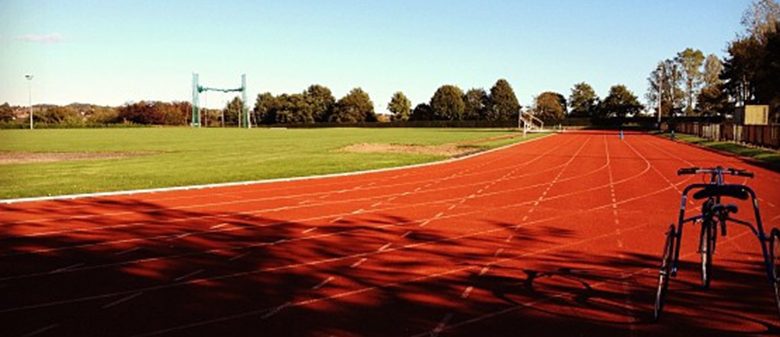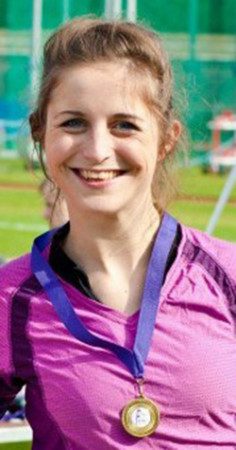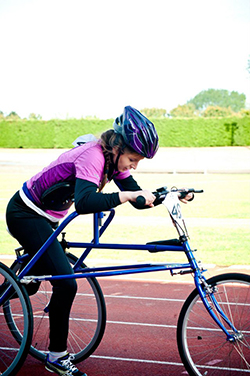
RaceRunning: have you heard of this athletic disability sport?
19-year-old Hannah Dines shares her experience of RaceRunning, a disability sport that enables people with mobility issues to race on a running bike. It is a disability sport that has not reached the bright lights yet, but it certainly can change peoples’ lives.
The warm breeze flew around me, the soft green grass whispered upon my bare feet, the sun glanced off my skin; I was going so fast the elements could only grasp but never hold. I was running over a prairie, so large there were no edges. So empty there could only be me.
This is a recurring dream of mine, from as long ago as I can remember. In early childhood I had no idea what it meant, only that it was one of my favourite make-believe places. I think it must have epitomised freedom to me – from dreary, wintery Glasgow. From the concrete of the city. From the reality of my disability.
 From a very early age, cerebral palsy (irreparable damage to a particular part of my brain tissue as a newborn) left me with reduced motor ability, poor balance, high muscle tone and slow malformation of leg and foot soft tissues. This was then, and will always continue to be, fine by me. I do not have any paralysis, I have all my senses and I can get myself from a to b.
From a very early age, cerebral palsy (irreparable damage to a particular part of my brain tissue as a newborn) left me with reduced motor ability, poor balance, high muscle tone and slow malformation of leg and foot soft tissues. This was then, and will always continue to be, fine by me. I do not have any paralysis, I have all my senses and I can get myself from a to b.
Yet as a child at school, careering around the playground, I was always restricted by the teachers. It was “too fast” and “too much danger”. Furthermore, I was outraged that I had to be poked and stretched by strange physiotherapists in nursery when I could have been making animals out of Play-Doh. I was also distraught to have a ‘helper’ in primary school to slowly take my shoes on and off when everyone else did theirs by themselves.
The world never responded to my cerebral palsy as fine. It was only later that I realised there were things other people could do that I couldn’t. I finally came to the conclusion that I must have a disability.
Running was one of the most prominent things that got to me. I knew that, for me, moving was a nuisance; I disliked it and avoided it at all costs. When I saw my class mates running, they looked like it was the best thing in the world. Their expressions enchanted me – there was determination, exertion, joy. One movement flowed into another, pushing their bodies to the limit, faster than anything.
Sports days were the worst after me. We would all line up, knock-kneed kid after knock-kneed kid, me at the end hanging onto my Kaye Walker, raring to go. I would get a head start and hurtle off. Then, puzzled, I was watching the backs of my friends disappear in the distance.
Willing my body, I jolted onwards. No matter how much I strained, I could not catch up. I was invariably left alone with all the parents who felt it was their duty to guiltily patronize me; “come on, you can do it Hannah”, which just made the contradictory fact plainer to see. All the sports days of my primary school played out like this – false encouragement, failure, frustration. I vowed I would never race again.
This held true throughout various operations, orthoses and physiotherapy, which enabled me to learn to walk independently of my Kaye Walker. This was a huge leap forward for me, and one I wish I had taken greater advantage of. But movement remained only a necessity.
Then things changed. It was the summer after my first year at University. I was casually flicking through a magazine. But, it wasn’t just any magazine, it was the magazine that would change my life.
It was one particular photo which drew me in. A face. An expression. It took me back to my early childhood and the children running about in the playground, full of elation and the delight of exercising. His legs were free, his torso tilted by a small chest plate, his arms outstretched to meet handle bars. What I was looking at was a wonderfully designed piece of engineering, but what reached me was that this boy was running.
 What began then was a fast-track journey that really put the fast into the track. With massive encouragement, guidance, time and effort from the heads of Ace RaceRunning Club, and a freelance coach from Red Star Athletics, I was sitting on a RaceRunner within a week.
What began then was a fast-track journey that really put the fast into the track. With massive encouragement, guidance, time and effort from the heads of Ace RaceRunning Club, and a freelance coach from Red Star Athletics, I was sitting on a RaceRunner within a week.
I felt so welcomed and so at home. It was the friendly faces and pats on the back that got me through my first time on a RaceRunner. Anyone who experiences being supported by a saddle whilst trying to move their pelvis around will know that it has the feeling that they are being given several unforgiving wedgies.
What was important for me, though, was something very significant within the experience. Maybe it was because I could move my legs so fast or that I felt almost graceful. Whatever it was, I felt it lighting me up and lifting my spirits. I was not going to let that go for a bit of discomfort, not for anything.
Now racing is the best thing in the world. Every time I am standing at the starting line, the glimmer I had felt, nudging under the surface, seems to expand inside me. It urges me on, pushing me to limit. I feel sure the brightness inside me is hope. The breeze flies around me, the ground glides beneath my feet, the sun on my skin. I am going so fast that none of the elements can hold me back. I am running.
Sport in its definition is the human need to experiment with (and stretch the limit of) motor function. Cerebral palsy is its exact antithesis. It destroys motor function, balance, ability to weight bear, direct oneself and co-ordinate movement.
 What I had experienced in that first race was freedom from all of those things. The RaceRunner holds you up just enough so that you can hold yourself up. Its chest plate gives you back your balance, its wheels start you moving, and its handlebars give you the power of direction. It takes away your disability, replacing it only with ability. It made my dream a reality.
What I had experienced in that first race was freedom from all of those things. The RaceRunner holds you up just enough so that you can hold yourself up. Its chest plate gives you back your balance, its wheels start you moving, and its handlebars give you the power of direction. It takes away your disability, replacing it only with ability. It made my dream a reality.
For 9 months I never wanted to get off that thing. It not only showed me my own aptitude to do sport, but also allowed me to find talent in other areas of my life. I am happy and healthy in mind and body; excelling within my university, with an everlasting stamina, readily available stress relief and frequent endorphins. I have not slowed down nor looked back since. There are still challenges, but none of these seem insurmountable any more, combined with my determination and the freedom that the RaceRunner gives me, I am unstoppable!
The world of RaceRunning is itself a limitless prairie – a body of invaluable people, who like the RaceRunner itself, aim to turn disability into ability. The question is, did the creator Connie Hansen realise, when engineering her masterpiece, that she was not only creating a sport, but was unleashing RaceRunners, fueled by hope, with an intent to widen the landscape of disability sport? We are running forward, running for progress, running for freedom, a RaceRunning revolution.
By Hannah Dines
Check out…
- Snowbility: skiing no matter what your ability
- ST Motorsport: accessible adrenaline
- Disability sport: don’t be afraid to try new things
Do you take part in any sports? We’d love to hear about it. Get in touch by messaging us on Facebook, tweeting us @DHorizons, emailing us at editor@disabilityhorizons.com or leaving your comments below.
I’ve experienced the similar barriers growing up and I feel your story will help many disabled people.
Excellent Article Hannah!
I’ve certainly experienced something similar with Disability Sport particularly being in Wales nothing ever seems to filter down the further West you go.
It’s also more frustrating because I’ve recently discovered I’m in that ‘Too Able-Not Able Enough’ Grey area
I’m research new sports. Who knows maybe I’ll give RaceRunning & maybe we’ll set up a DH Challenge 🙂